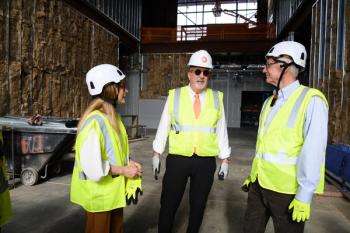
Building better health into your veterinary hospital
Good design is more than building codes and aesthetics. Employ these innovative evidence-based designs to boost patient, client, and team member health.
If you’re wavering on whether to splurge on the striking water feature for your entryway, go for it. And if you’re wondering whether you need another window in the boarding area, chances are you do. Because while building a new veterinary facility offers you more space, an efficient layout, and an updated look, it can also mean better health for you, your team members, your clients, and their pets.
Research shows a link between a building’s interior environment and the health of the people in it. Such simple strategies as masking noise, increasing sunlight, and improving airflow can lead to better and faster healing, higher productivity, and more relaxation for those under stress. Called “evidence-based design,” this concept is now touching the veterinary design world. To incorporate these new innovations, here are some details to consider.
Music to your ears
Veterinary practices aren’t generally known for being quiet, calm places to visit and work. But evidence shows that improving noise control and introducing positive background noise during the building process and after can reduce stress for team members as well as clients and patients. Techniques to make it happen include:
Acoustic ceilings. One of the simplest ways to drive down errant background noise is to use suspended acoustic ceiling tiles with a high NRC (noise reduction coefficient), says Mark Hafen, AIA, a founding member of Animal Arts, a veterinary design firm based in Boulder, Colo. A ceiling tile like the kind used in open office plans usually has an NRC of 0.75, which means it absorbs 75 percent of the noise bouncing around the room. Concrete floors and concrete block walls have an NRC of 0.
Fabric and furnishings. Hafen, a Veterinary Economics Editorial Advisory Board member, suggests using carpet in office and conference areas to dampen noise. Also, consider installing fabricwrapped acoustic panels or acoustic baffle panels on the walls. They’re decorative and have an NRC of 1. Upholstered furnishings in the waiting area alsohelp reduce noise.
Floor plan. A good floor plan will eliminate many noises by isolating animal areas from the office and medical areas. You can also use dense acoustic walls, cages in glass-fronted acoustic wards fronting on the treatment areas, and sound absorption in the wards. Hafen also suggests you eliminate your paging system to reduce even more noise and interruptions.
Good noise. Don’t stop at reducing the noise from barking dogs and hissing cats. Make sure to introduce good noise in your facility, says Wayne Usiak, AIA, senior partner with BDA Architecture in Albuquerque, N.M. “Adding a water fountain or music can go a long way toward masking distracting noises in a veterinary hospital,” says Usiak, a member of Veterinary Economics’ Editorial Advisory Board.
Hafen offers another good noise option: a white-noise machine, common in many office environments.
Let the sunshine in
In human medicine, more and more studies are finding that people feel less stressed, perform better, and recuperate faster when they enjoy ample amounts of fresh air and sunshine. There is a direct link between exposure to sunlight, the body’s production of melatonin and vitamin D, and the body’s ability to self-regulate and resist contagions.
Specifically, studies in human hospitals have found that sunlit rooms shorten recuperative time more than rooms with windows but without direct sunshine, Hafen says. Studies also show that full-spectrum fluorescent lighting is better for recuperation than conventional types of fluorescent lighting.
Not only will pets recuperate faster, but staff members will work more quickly and with more accuracy when exposed to natural daylight. So think of adding windows and skylights whenever possible. Want to boost your retail sales while you’re at it? A recent study shows a 20 percent increase in purchasing in daylit areas. (
Consider the natural circadian rhythm
Despite our need for bright light throughout the day, we also crave the natural cycles of day and night. Researchers have found that these cycles—otherwise known as the circadian rhythm—regulate body functions and lower stress levels in people, Usiak says.
Patients recover faster, and team member absenteeism, turnover, and morale are improved when people and animals are exposed to bothdirect sunlight and cycles of day and night, Usiak says: “Everyone wins.”
Including the environment. Improved use of daylight reduces the need for artificial light, which cut backs on energy use. In addition, correct placement of windows and skylights can warm a building, as needed, reducing heating costs in the winter.
And while daylight is important, don’t forget the night cycle for your patients. All pets need secure, quiet darkness at night to recuperate from the stress, exercise, and socializing of the day and to balance out the daytime light.
Bring the outdoors in
Walking in the woods is generally more calming than, say, sitting in a gray room with stark walls and cold, canned air, right? Then it stands to reason that by giving clients and staff members views of the outdoors, you can reduce the natural stress they feel when they’re concerned about pets and patients. And these same views help animals as well.
“But it can’t be just any view,” Usiak says. A busy street outside won’t do the trick. “It has to be a view of substance—a tree, a park, a garden, or some form of nature, not just a brick wall in a courtyard.”
If you can’t provide lush views for your patients and staff, try bringing the outside in. Usiak recommends adding skylights in bird rooms, aquariums for cats to look at, and greenery indoors for pets as well as clients and staff to enjoy. “You can market the cat cages that see the aquarium as ‘ocean-view rooms,’” Usiak quips. Aquariums are also a good idea in areas where clients wait, as they’ve been shown to reduce stress in people.
If you have the space to dedicate to a memorial garden or outdoor waiting area, consider doing so. Size doesn’t always matter, though. “I’ve seen small Zen gardens with decorative rock and a few strategically placed plants in a very small walled-in alcove or garden that achieve the same effect,” Hafen says.
Breathe easy
Using filtered outside air and high-efficiency filtration improves fresh air circulation, reduces transmitted infections, and is more energyefficient, Usiak says. Plus, team member productivity improvesthe more thermally comfortable your building is.
In fact, the most recent set of standards from the U.S. Green Buildings Council stress improving indoor air quality. This is often accomplished by reducing the use of volatile organic compounds (VOCs) and preventing the off-gassing of petroleum-based products like vinyl or carpet, or formaldehyde off-gassing from the particleboard in cabinetry, Hafen says. You can also improve air quality by reducing odors from improperly cleaned cages and runs.
To improve air ventilation in your hospital, Hafen recommends that you ensure that your system provides plenty of air changes in kennel areas (12 to 14 air changes per hour is a good benchmark) and exhausts unclean or used air outside instead of recirculating it around the hospital. Hafenalso recommends that you install emergency exhaust fans.
Another big source of poor air quality is cleaning products. “I’m a big proponent of using nontoxic cleaning supplies whenever possible,” Usiak says. “Choosing the right materials can reduce respiratory issues and asthma problems, and even reduce the costs of cleaning the air in a practice.” But don’t justrely on a “green” label, Usiak says. Look for products without VOCs.
There’s a lot to consider when you try to make your practice a healthy building, but remember that any little change makes a difference in the lives of staff, clients, and pets. Start small, and keep making healthy changes—and enjoy the rewards of a happier, healthier practice.
Sarah Moser is a freelance writer and editor in Lenexa, Kan. E-mail comments or questions to
Continue on for great photos of veterinary hospitals that bring these ideas to life ...
Photo by David Dietich
Light up their lives: Warm sunlight bathes the waiting area of Upstate Veterinary Specialists in Asheville, N.C., while a six-foot stone monolith fountain adds the sound of flowing water. Research shows sunlight and outdoors elements lower employee and patient stress.
Photo by Sandy Agrafiotis
A perfect view: A forest scene beats sterile hospital walls when it comes to cultivating calm. Windows in this waiting area at Maine Veterinary Referral Center in Scarborough, Maine, look out on peaceful views that translate into peace indoors for patients, pet owners, and team members.
Photo by Sandy Agrafiotis
A perfect view: A forest scene beats sterile hospital walls when it comes to cultivating calm. Windows in exam rooms at Maine Veterinary Referral Center in Scarborough, Maine, look out on peaceful views that translate into peace indoors for patients, pet owners, and team members.
Photo by Thomas McConnell
Porch of peace: Chairs, a swing, and a flowering garden of hardy plants invite visitors to stop while they're outside Zoot Pet Hospital in Georgetown, Texas. The porch is a favorite spot for reflection.
Photo by Thomas McConnell
Rhythm of the night: Zoot Pet Hospital's cat condos offer feline boarders an appealing view of the outdoors day and night. Pets benefit from the healing power of the circardian rhythms of daylight and darkness.
Photo by Thomas McConnell
Glass house: The indoors-lodge feel of Zoot Pet Hospital in Georgetown, Texas, is complemented by high clerestory windows providing lots of natural light and a calming view of the hospital's outdoor surroundings.
Photo by Joseph Mills
Ideal work light: The surgery suite at Yukon Hills Animal Hospital in Yukon, Okla., uses an outdoors view to lower team member stress.
Just beachy: Tropical plants transform the walkways around Calusa Veterinary Center in Boca Raton, Fla., into a haven for waiting clients and stressed patients.
Turtle temptation: Acacia Animal Health Center in Escondido, Calif., offers a Zen garden of plants, stone, and sand for team members to rest and unwind on breaks.
Newsletter
From exam room tips to practice management insights, get trusted veterinary news delivered straight to your inbox—subscribe to dvm360.





